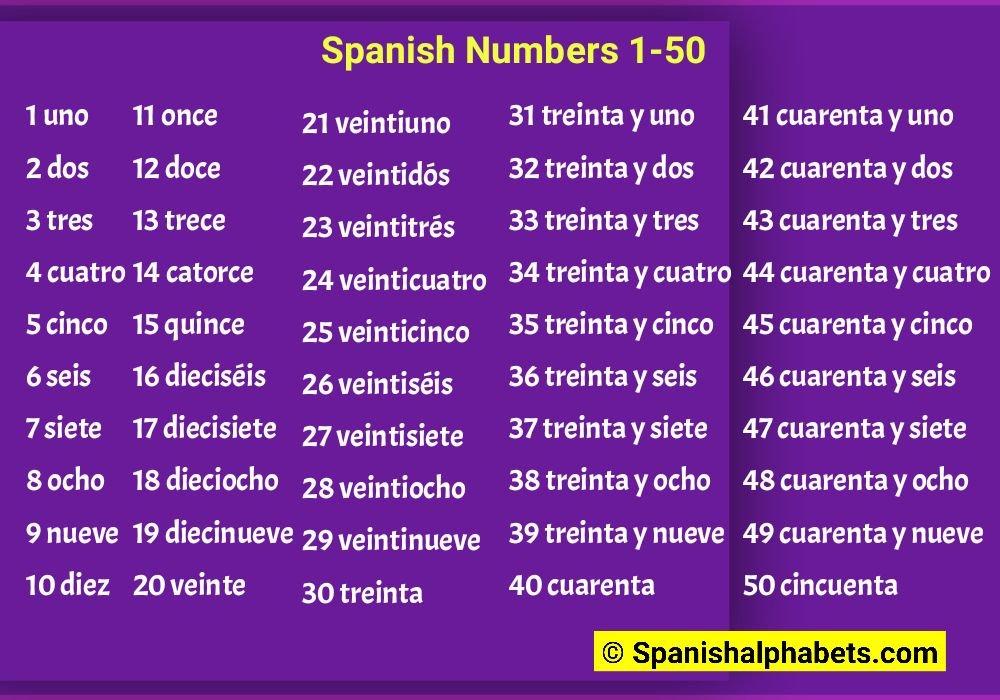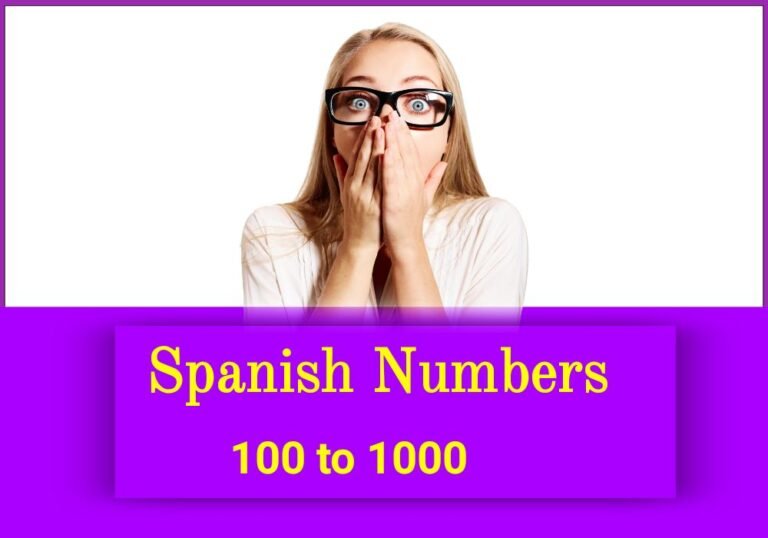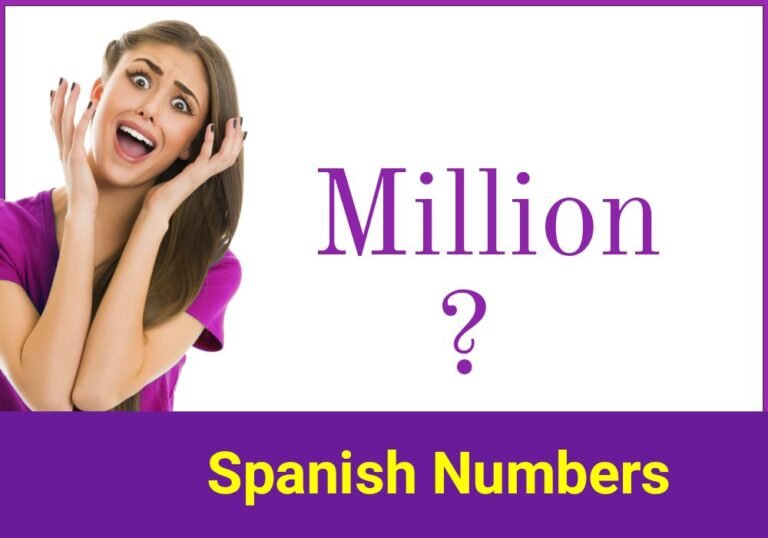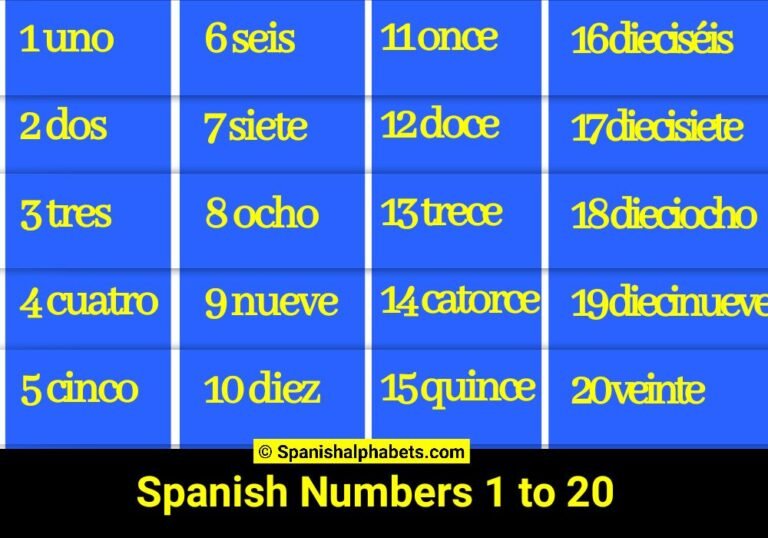Learning a new language is always an exciting adventure, and mastering the basics is like unlocking a new world of possibilities.
If you’ve been eager to learn Spanish, you’ve come to the right place!
At spanishalphabets.com, we understand that numbers are essential to any language, allowing us to communicate and understand quantities.
That’s why we have developed a fast method to help you learn Spanish numbers 1-50 in no time. And the best part?
We have included audio content so you can listen and practice pronunciation. Get ready to dive into the world of Spanish numbers and expand your linguistic horizons with our easy-to-follow guide!
Spanish Numbers 1-50
According to a recent study, only about half of Americans can confidently spell and say Spanish numbers 1 to 50. This lack of knowledge could be costly, as many businesses require bilingual employees.
One reason for the difficulty may be that the numbers must be pronounced phonetically.
For example, 13 is trece, not tres-teen. Additionally, there are many irregularities in the way they are spelled. For example, 40 is cuarenta, not catorce.
| No. | Spanish | Pronunciation |
| 1 | uno | oo-no |
| 2 | dos | dose |
| 3 | tres | trace |
| 4 | cuatro | kwat-ro |
| 5 | cinco | sink-o |
| 6 | seis | saze |
| 7 | siete | see-yet-eh |
| 8 | ocho | och-o |
| 9 | nueve | new-eh-veh |
| 10 | diez | dee-ace |
| 11 | once | ohn-say |
| 12 | doce | dos-say |
| 13 | trece | treh-seh |
| 14 | catorce | ca-TOR-say |
| 15 | quince | KEEN-say |
| 16 | dieciséis | dee-AY-see-saze |
| 17 | diecisiete | dee-AY-see-see-AY-tay |
| 18 | dieciocho | dee-AY-see-och-o |
| 19 | diecinueve | dee-AY-see-new-EH-veh |
| 20 | veinte | Veh-een-tee |
| 21 | veintiuno | Veh-een-tee-oo-no |
| 22 | veintidós | Veh-een-tee-DOS |
| 23 | veintitrés | Veh-een-tee-TRACE |
| 24 | veinticuatro | Veh-een-tee-KWAT-ro |
| 25 | veinticinco | Veh-een-tee-SINK-o |
| 26 | veintiséis | Veh-een-tee-saze |
| 27 | veintisiete | Veh-een-tee-see-ay-tay |
| 28 | veintiocho | Veh-een-tee-OCH-o |
| 29 | veintinueve | Veh-een-tee-new-EH-veh |
| 30 | treinta | treh-een-tah |
| 31 | treinta y uno | treh-een-tah ee oo-no |
| 32 | treinta y dos | treh-een-tah ee DOS |
| 33 | treinta y tres | treh-een-tah ee tres |
| 34 | treinta y cuatro | treh-een-tah ee KWAT-ro |
| 35 | treinta y cinco | treh-een-tah ee SINK-o |
| 36 | treinta y seis | treh-een-tah ee saze |
| 37 | treinta y siete | treh-een-tah ee see-ay-tay |
| 38 | treinta y ocho | treh-een-tah ee OCH-o |
| 39 | treinta y nueve | treh-een-tah ee new-EH-veh |
| 40 | cuarenta | kwar-EN-tah |
| 41 | cuarenta y uno | kwar-EN-tah ee oo-no |
| 42 | cuarenta y dos | kwar-EN-tah ee DOS |
| 43 | cuarenta y tres | kwar-EN-tah ee tres |
| 44 | cuarenta y cuatro | kwar-EN-tah ee KWAT-ro |
| 45 | cuarenta y cinco | kwar-EN-tah ee SINK-o |
| 46 | cuarenta y seis | kwar-EN-tah ee saze |
| 47 | cuarenta y siete | kwar-EN-tah ee see-ay-tay |
| 48 | cuarenta y ocho | kwar-EN-tah ee OCH-o |
| 49 | cuarenta y nueve | kwar-EN-tah ee new-EH-veh |
| 50 | cincuenta | sink-KWEN-tah |
This lack of knowledge can be remedied with some practice. Learning basic Spanish numbers is an excellent place to start for anyone interested in becoming bilingual.
With some effort, you can confidently spell and say Spanish numbers 1 to 50 in no time!
Can you spell Spanish numbers 1 to 50 without looking?
Can you spell Spanish numbers 1 to 50 without looking? This is a difficult question to answer. The reason is the Spanish language uses a different alphabet than English.
Therefore, some of the letters and numbers may need to be clarified. However, if you are familiar with the Spanish alphabet, you should be able to spell the numbers 1-50 without too much trouble.
In Spanish, the numbers one through ten are spelled relatively quickly. After that, however, the spelling becomes more complicated to remember.
Can you spell all of the numbers from one to fifty without looking? Here are some tips to help you spell Spanish numbers correctly:
When spelling numbers 11-19, always use a hyphen (-) between the tens and the ones digit. For example, eleven is spelled “once,” twelve is spelled “doce,” thirteen is spelled “trece,” and so on.
The word for 20 is “veinte.” To spell 21-29, start with “veinti” and add the appropriate digit.
- 1 uno
- 2 dos
- 3 tres
- 4 cuatro
- 5 cinco
- 6 seis
- 7 siete
- 8 ocho
- 9 nueve
- 10 diez
- 11 once
- 12 doce
- 13 trece
- 14 catorce
- 15 quince
- 16 dieciséis
- 17 diecisiete
- 18 dieciocho
- 19 diecinueve
- 20 veinte
- 21 veintiuno
- 22 veintidós
- 23 veintitrés
- 24 veinticuatro
- 25 veinticinco
- 26 veintiséis
- 27 veintisiete
- 28 veintiocho
- 29 veintinueve
- 30 treinta
- 31 treinta y uno
- 32 treinta y dos
- 33 treinta y tres
- 34 treinta y cuatro
- 35 treinta y cinco
- 36 treinta y seis
- 37 treinta y siete
- 38 treinta y ocho
- 39 treinta y nueve
- 40 cuarenta
- 41 cuarenta y uno
- 42 cuarenta y dos
- 43 cuarenta y tres
- 44 cuarenta y cuatro
- 45 cuarenta y cinco
- 46 cuarenta y seis
- 47 cuarenta y siete
- 48 cuarenta y ocho
- 49 cuarenta y nueve
- 50 cincuenta.
How to Pronounce Spanish Numbers 1-50
To correctly pronounce Spanish numbers 1-50, you must first understand the rules of Spanish pronunciation. Generally speaking, Spanish numbers follow a specific pattern when spoken aloud.
However, there are some important exceptions to keep in mind. The first thing to keep in mind is that the letter “c” is always pronounced like an “s” sound, and the letter “z” is always pronounced like a “th” sound.
The number 13 is pronounced as “trece,” not “treinta y uno.” The number 15 is pronounced as “quince,” not “catorce.”
To pronounce Spanish numbers 1-10, just add an -o to the end of each number: uno, dos, tres, etc. For 11-19, say the number followed by -teen: once, doce, trece, catorce, quince. For 20-29, say veinti and then the number: veintiuno, veintidós.
From 30-39, it’s treinta y plus the number: treinta y uno, treinta y dos. Forty is cuarenta; 50 is cincuenta.
1 to 10 Pronunciation
- 1 uno
- 2 dos
- 3 tres
- 4 cuatro
- 5 cinco
- 6 seis
- 7 siete
- 8 ocho
- 9 nueve
- 10 diez
11 to 20 Pronunciation
- 11 once
- 12 doce
- 13 trece
- 14 catorce
- 15 quince
- 16 dieciséis
- 17 diecisiete
- 18 dieciocho
- 19 diecinueve
- 20 veinte
21 to 30 Pronunciation
- 21 veintiuno
- 22 veintidós
- 23 veintitrés
- 24 veinticuatro
- 25 veinticinco
- 26 veintiséis
- 27 veintisiete
- 28 veintiocho
- 29 veintinueve
- 30 treinta
31 to 40 Pronunciation
- 31 treinta y uno
- 32 treinta y dos
- 33 treinta y tres
- 34 treinta y cuatro
- 35 treinta y cinco
- 36 treinta y seis
- 37 treinta y siete
- 38 treinta y ocho
- 39 treinta y nueve
- 40 cuarenta
41 to 50 Pronunciation
- 41 cuarenta y uno
- 42 cuarenta y dos
- 43 cuarenta y tres
- 44 cuarenta y cuatro
- 45 cuarenta y cinco
- 46 cuarenta y seis
- 47 cuarenta y siete
- 48 cuarenta y ocho
- 49 cuarenta y nueve
- 50 cincuenta.
What Americans Need to Know About Spanish Numbers 1-50
Americans need to know how to count to fifty in Spanish. Here are some helpful tips:
The numbers are nearly the same as in English when counting from one to ten in Spanish.
The only exception is that the number four is pronounced “cuatro” instead of “four.” From eleven to nineteen, the numbers are different. Eleven is “once,” twelve is “doce,” thirteen is “trece,” and so on.
The numbers twenty through fifty follow a pattern similar to eleven through nineteen. Twenty-one is “veintiuno,” thirty-three is “treinta y tres,” and forty-five is “cuarenta y cinco.” It is important to remember that the word “and” (“y”) connects the two numbers in these cases.
Why Learning Spanish Numbers, 1-50 is Important
Spanish numbers 1-50 are essential for several reasons. For one, they provide an essential foundation for learning the language.
They also help with counting, telling time, and understanding prices. Additionally, being able to count in Spanish can be helpful when traveling to Spanish-speaking countries.
Spanish is the world’s second most widely spoken language, with more than 400 million speakers. That’s many people you could communicate with if you learn Spanish!
In addition to giving you access to more people, learning Spanish can also help you in your career.
Many businesses are international, and being able to speak Spanish will give you an edge over other candidates who can only speak English.
Finally, learning Spanish can be a fun and rewarding experience. It’s a beautiful language, and by learning it, you’ll be able to appreciate better the culture and cuisine of Spain and Latin America. So what are you waiting for? Start learning those numbers 1-50 today!
Conclusion Points
To learn Spanish numbers 1-50, we first need to understand the structure of the language. Spanish is a Romance language that evolved from Latin. Over 500 million people speak it in 21 countries.
The number system in Spanish is similar to the one used in English. However, there are some essential differences that we need to be aware of.
The first thing to note is that Spanish has both masculine and feminine forms of numbers. For example, the number “one” can be either masculine (uno) or feminine (una).
The second thing to remember is that when counting from 21-29, 31-39, 41-49, and so on, the numbers must agree with the gender of the noun they modify. So if you’re referring to a group of male friends, you would use masculine numbers.
FAQs
Welcome to the FAQs section of Spanishalphabets.com! Here, you can find answers to some common questions about spelling and saying Spanish numbers 1 to 50.
You can also ask questions in the comment box on Can You Spell and Say Spanish Numbers 1 to 50? This is an excellent resource for anyone who wants to learn more about the Spanish language and numbers.
Question (1) – How do you say even numbers in Spanish?
Answer – In Spanish, the word for “even” is “par.” To say an even number, you would say “par” followed by the number. For example, “two” is “dos,” so “even two” would be “par dos.
Question (2) – How do you say number two in Spanish?
Answer – In Spanish, the word for “two” is “dos.” To say “number two,” one would say “el número dos.
Question (3) – How do you say number three in Spanish?
Answer: In Spanish, “three” is “tres.” To say “number three,” you would say “el número tres.”
Question (4) – How do you say number 50 in Spanish?
Answer – In Spanish, 50 is written as “cincuenta.” This number is pronounced as “seen-koo-ehn-tah.
Question (5) – What is the number 50 in Spanish?
Answer: The number 50 in Spanish is cincuenta. This is pronounced as seen-KWEN-tah. The word cincuenta comes from the Latin word for fifty, quinquaginta.
In Spanish, the letter “c” before an “e” or an “i” is pronounced like an English “th” sound. Cincuenta is typically used when referring to the number 50 in Spanish.
Question (6) – What are the 50 pronouns in Spanish?
Answer: There are 50 Spanish pronouns used to replace nouns in a sentence. These pronouns can be divided into personal, reflexive, demonstrative, and interrogative.
Personal pronouns refer to specific people or things, reflexive pronouns are used when the subject and object of a verb are the same, demonstrative pronouns are used to point out specific people or things, and interrogative pronouns are used to ask questions.






